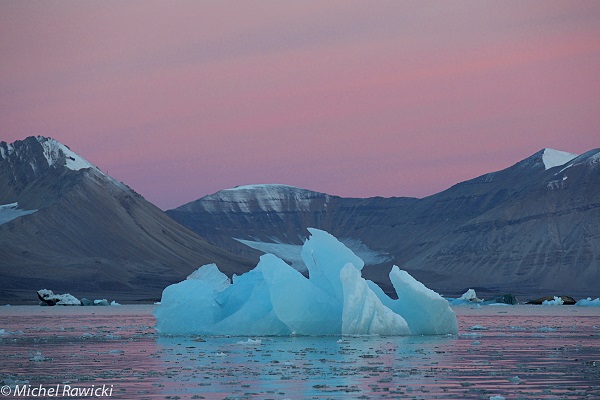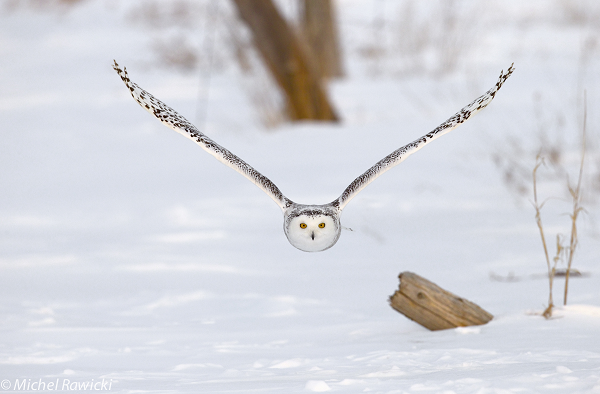Nature and wildlife photographer Michel Rawicki shares with Gaia Discovery what he has observed about nature in the Polar Regions, and how the climate is changing the environment in parts. Rawicki is a guest of Voilah! festival, which presents his large scale prints in an outdoor exhibition themed Touched by the Cold.
Photographer Michel Rawicki reports nature's predicament through pictures
Singapore, 2 April 2018. In 1993, an intrepid photographer was struck by the beauty and majesty of the poles, altering his path into capturing icy landscapes, wildlife and people through the lens.
He was already 43 years old then and well into his photographic career (he also founded StockImage). But since then, Paris-born Michel Rawicki has spent the last 25 years travelling in cold, cold places in the Arctic and Antarctica to document stories of nature that is both beautiful, and wild.
As well, Rawicki’s photos often convey silent messages of survival and adaptation as the Inuits live in harsh conditions of the cold. But has climate change brought about a change in the way things used to be for them, and for the polar bears? Mallika Naguran poses these questions to him over coffee.
What do you see your role as a photographer?
My first approach as a photographer was essentially aesthetic. My medium is to give the beauty and transform partly the world in a better shape with the beauty of nature. And curiosity as well! I’ve been travelling since I was a kid where I first had the idea of embracing the cold while taking pictures of the Aiguille du Midi and discovering the caves that were 4,000 metres high. So for me, travelling and photography are mixed.
Thereafter teaching and reporting – I no longer take pictures only for myself. The idea is to share and to create a link with everyone. Which is what I am doing in Singapore at Voilah! where people look at and wonder about the photos displayed.
Michel Rawicki photographs ice for its majesty and discusses its role in the balance of nature
My role did change gently year after year to go into the consciousness of nature’s beauty. The cold is the memory and the future of humankind – so let’s protect, let’s take care, let’s respect. And it is really an inner personal revolution that we all have to work with. We need the consciousness as this beauty is fragile. And this fragility comes with the consciousness that the ice in the North Pole has reduced by more or less 30% in 30 years since the 1980s until 2012.
In the course of your work, what have you observed about the ice blocks in the Polar Regions over time?
I have seen with my own eyes that change has taken place. In 1995 I was on a reportage assignment of the biggest Dog Sled race ever built for the Guinness Book of Record. This was with a friend of mine so we made the trip together to Greenland. Our sled had 156 dogs and 20 mushes managing all that together, and it was the shortest distance covered as it broke after 100 metres! You can still see on Google Maps the wrecked bits of the famous 20 metre long wooden sled at the Ilulissat Airport.
At that time I saw the ice being around one metre thick. I went back in the same March-April period in 2010, and saw that the sea had opened allowing boats to pass through the back. There were just pieces of ice bergs instead of just ice bloc. So does that mean, 15 years later, would the ice go back even further, say 300 kilometres northwards? Which doesn’t mean to say that a year later it would be the same? It is predictable but it isn’t scientifically verified.
And then I went back again in 2012 to find the ice. I took a trip to Melville Bay in Greenland and went way up North for two weeks with my two Inuit colleagues. The ice in April was fine enough for a trip to be made on.
The ice cap, though, is melting even with the global average temperature reduction targets of below 2 °C above pre-industrial levels set by the Paris Agreement in 2015.
Are you convinced that this is due to climate change?
I am not a scientist, I just verify with my eyes. I am convinced that we are living in a dramatic and changing climate for sure! For reasons such as industrial activity, farming activity and the melting permafrost, there is change in the water in this region. Because global warming is occurring quicker in the Arctic than the rest of the world; because of the new or recent ice replacing the parent or the old ice, which is melting much quicker than before. The old ice helps to protect the cold water.
So I am conscious of climate change, of course; so my pictures are selling dreams, beauty and the happiness associated with the environment.
The nuptial dance of the Red Crown Cranes of Japan captured by Michel Rawicki
Are you seeing changes to the habitats of wildlife?
I have not observed any major changes in the Polar Regions; the polar bear population is still dense at more than 25,000. There is still snow and ice in many regions, for instance in Manitoba of Canada and in Svalbard of Norway where the ice is melting later than the previous years because of greater ice deposited in the North. It is unpredictable year after year how the ice is going to move.
Today the habitat changes are not visible. The hunting season of the polar bears still remains between September to June, which is their real hunting period up North. I will be there next month to check on this, and I will note and report about the shape of the bears and their behaviour.
I do see, however, that we are losing our birds and bees in Europe; birds due to the massive use of pesticides.
What is sure is that the North West passage of the Arctic is open now, which means the summer ice is about 28-30% less than the beginning of the 1980s. And it is a vicious circle because it is going quicker decades after decades. I am more than upset of what is happening.
Are you worried?
Of course I am worried about what is going to happen in 10 to 20 years. I don’t want to teach children about bears by looking only in books. That’s the main issue!
What are your observations about the Arctic communities surviving harsh environments and their adaptation to climate changes?
I note a change, for instance, the fishing period of the Inuit in the open water on Greenland is starting earlier in February rather than the usual in May. So the hunters of seal on ice now turn to become hunters of fish. To fish, what they do is to make a hole in the ice, then sleep in a basic tent pitched over their sled for a few days until they get the fish. Or they go out to sea by boat.
I am much more concerned about another problem. We are not talking about global warming but a sister problem, which is also a big one – plastic in the ocean! Also there are heavy metals, which are strongly contaminating marine life, the big fish especially, caused mainly by the industries from the big countries.
Having spent time with the Inuit in Greenland and Canada, I sense that they are also losing their culture; even with the government’s help, modern life is taking over too quickly. Although there is no running water there, there is the Internet - even in the tiniest village up north! While this is a good thing for communication, it could affect their culture.
Change is taking place even with the Inuit communities due to the Internet. Photo by Michel Rawicki.
It is too early to tell how climate change affects the Inuit. They are still eating and reproducing well. The melting of the ice in the North West passage will be good for business though. It saves time to bring things across and thus saves money. The big tankers going up North is not very romantic though!
Some of the animals in your photos seem to be moving like a dance. Is that the effect you intended to create?
The grace, beauty and fragility of nature captured in Touched by the Cold exhibition by Michel Rawicki.
That’s my sensitivity, that’s my emotion, that’s my way of taking pictures. To show and share the beauty; I am not into showing lions fighting although I do have photos of eagles fighting over fish.
Again, it is patience, practice and perseverance. The way to feel and transmit your passion – I want to show beauty, I want to show grace. Like the nuptial dance of the Red Crown Cranes in Japan.
They seem poetic!
You can say that. My job is to capture the poetic message – maybe it is the feminine side of me when I work with the animals.
The bearded seal in Svalbard was captured in a Zodiac which was tricky as it was playful, darting back and forth. After three times of trying, I finally snapped a good shot.
What particular hardship did you endure in the course of your work?
I nearly lost my little finger while waiting in the cold enjoying the Northern Lights in Hudson Bay. I had exposed my skin while changing gloves to adjust the camera settings. After going back to the little cabin in the middle of nowhere, my finger had turned greyish-black. Not very sexy! I did what I could with what I had then. But I suffered numbness of my little finger for eight months thereafter due to being out in the cold for hours.
But you are usually careful?
Oh yes, but there was this incident in Melville Bay where I was relaxing and meditating on a rock and the dogs were sleeping. I was observing the beauty of an ice prism at sunset. One hour later my Musher alerted me to a polar bear that was spotted some 300 metres away. Upon gathering my equipment, I turned around and saw that the bear suddenly appeared 10 metres behind me.
Patience and perseverance does it. Photo by Michel Rawicki as displayed at Touched by the Cold exhibition in Singapore at the Voilah! 2018 festival.
It was a male around 300 kg. It looked at me, smelled me, then turned around and left. I had a “special sensation”. I felt that I was protected by Mother Earth, or my good Karma!
In what other cities will your exhibition be featured in 2018? What is the next project?
My next book to be out in 2019 will be focused on polar bear only, entitled Nanuk, the Lord of Ice.
Next Summer I will be in Hudson Bay with the beluga whales. I tried to shoot them before from a Zodiac but didn’t get to capture them. So I will be going back and also to capture photographs of female polar bears and eight month old young bears in summer atmosphere.
I will be presenting four exhibitions from June to October 2018 in France. The last one, dedicated to polar bear, will go to the famous Musee Oceanographique De Monaco.
I deeply hope that the exhibition in Singapore will travel to other Asian cities.
Michel Rawicki’s exhibition is on from 1 April to 6 May 2018 at the Colonnade, Supertree Grove, Gardens by the Bay. Admission is free.
For event timings and further information on Voilah! festival, please visit www.voilah.sg.





